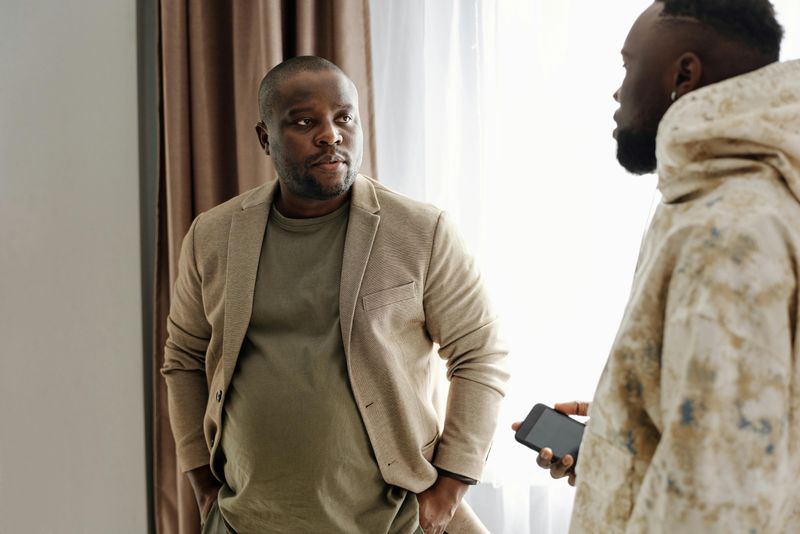12 Clever Phrases Smart People Use When They Know You’re Lying

We’ve all been in situations where someone’s story just doesn’t add up. While confronting a liar head-on can create awkward moments, smart people have mastered the art of addressing dishonesty without causing a scene. These clever phrases allow them to signal they’ve spotted the deception while giving the other person a chance to come clean gracefully.
1. That’s an interesting perspective.

When someone drops this seemingly innocent comment, they’re actually sending you a subtle message. They’re acknowledging what you’ve said without agreeing with it – a brilliant tactic that keeps the conversation flowing while creating distance from your questionable claims.
The beauty of this phrase lies in its perfect neutrality. It neither accepts nor rejects your statement, instead placing it in a category of subjective viewpoints rather than accepted facts. The person using this phrase has likely detected inconsistencies in your story.
Pay attention to their body language when they say this – often accompanied by a slight head tilt or raised eyebrow. They’re essentially saying, “I hear you, but I’m not buying it” without the confrontation that would make things awkward.
2. Oh, really? Tell me more about that.

This disarming invitation seems friendly on the surface, but it’s actually a clever trap. The person isn’t asking for more information because they believe you – they want you to keep talking because liars typically struggle with consistent details when forced to elaborate.
Smart people know that fabricated stories often fall apart under scrutiny. By encouraging you to expand on your tale, they’re giving you enough rope to potentially trip yourself up. They maintain an interested expression while mentally noting contradictions that emerge.
The genius of this approach is its non-confrontational nature. Rather than calling you out directly, they let you discover the weakness in your own story. Many liars realize midway through their expanded explanation that they’ve backed themselves into a corner.
3. That must have been… quite an experience.

Notice the strategic pause in this phrase? That hesitation speaks volumes. The person using it has heard your story and finds it questionable, but they’re maintaining politeness while creating emotional distance from your claims.
The word “quite” does heavy lifting here – it’s deliberately ambiguous. It could mean remarkable or unusual, but it often carries an undertone of skepticism. The speaker has chosen words that can’t be challenged as rude but clearly communicate doubt.
This phrase brilliantly maintains social harmony while allowing the speaker to avoid becoming complicit in your deception. They’re essentially creating a buffer zone – acknowledging they heard you without validating your story. When someone responds this way, they’ve likely spotted holes in your narrative.
4. I see. How did that come about?

When someone responds with this question, they’re tactfully applying pressure on the weakest point of most lies – the logistics. Fabricated stories often focus on dramatic outcomes while glossing over the practical details of how events unfolded.
The phrase begins with a brief acknowledgment before pivoting to a request for process. This approach is particularly effective because it sounds like genuine curiosity rather than an interrogation. The questioner maintains an expression of innocent interest while mentally evaluating the plausibility of your explanation.
Skilled conversationalists use this technique to expose inconsistencies without confrontation. They know that truthful accounts typically include natural cause-and-effect sequences, while lies often contain logical gaps. If you find yourself scrambling to explain “how” after telling a tall tale, you’ve encountered this clever strategy.
5. That’s one way to look at it.

This masterfully diplomatic phrase serves as a yellow caution flag in conversation. Without directly challenging your statement, the person signals they’re aware of alternative interpretations – including the possibility that you’re not being truthful.
The beauty of this response lies in its restraint. It acknowledges your perspective while subtly suggesting it may be flawed or incomplete. The speaker maintains plausible deniability about calling you a liar while clearly communicating their skepticism.
Watch for this phrase when you’ve presented something as factual that might actually be opinion or exaggeration. It’s particularly effective because it shifts the conversation from a binary true/false dynamic to a spectrum of perspectives. The person using it has likely identified your statement as self-serving or distorted, but they’re giving you room to save face.
6. Hmm, that’s surprising. I wouldn’t have guessed.

This seemingly innocent reaction actually carries a powerful subtext. The person is flagging that your claim contradicts their existing knowledge or expectations – without directly calling you dishonest. They’ve created a perfect verbal sidestep.
The “hmm” opener signals thoughtful consideration rather than immediate rejection. But make no mistake – they’re highlighting the improbability of your statement. They’re essentially saying, “This doesn’t align with what I know to be true” while maintaining conversational politeness.
Smart communicators use this phrase when they have contradictory information but want to avoid embarrassing confrontation. It puts the ball in your court to either backtrack or double down on your claim. If you hear this response, the person likely has reason to doubt you based on prior knowledge or simple logic.
7. Interesting choice of words.

This phrase targets the specific language you’ve used rather than the overall claim – a brilliant approach that makes liars suddenly self-conscious about their own speech patterns. Did they use an unusual term? Overqualify their statement? Employ suspicious vagueness?
The comment draws attention to your verbal choices without directly challenging your honesty. It’s particularly effective because it often causes liars to mentally review what they just said, sometimes leading to telling facial expressions or backtracking.
People who use this technique have usually noticed linguistic red flags – perhaps overly formal language, unnecessary details, or conspicuous omissions. They’re signaling awareness of these markers without making accusations. When someone comments on your “choice of words,” they’re likely noticing the subtle ways your language betrays your deception.
8. That’s curious. Can you walk me through it again?

This request for repetition seems innocent but serves as a powerful truth-testing tool. The person has likely spotted inconsistencies in your story and wants to see if you’ll tell it the same way twice – something liars often struggle with.
The word “curious” signals they’ve found something unusual or questionable in your account. By asking you to repeat yourself, they’re creating an opportunity to compare versions and identify contradictions. They maintain a pleasant, interested expression while mentally noting any details that shift.
Memory experts know that truthful accounts tend to remain consistent even when retold, while fabrications often change in subtle ways. If someone asks you to retell your story with this phrase, they’re essentially running a consistency check. They’ve created a simple but effective trap for catching deception without direct confrontation.
9. I hadn’t heard it explained quite like that before.

This elegant phrase signals doubt without rudeness. The person is essentially telling you that your version conflicts with their understanding or with commonly accepted information – but they’ve wrapped this challenge in polite language.
Notice how it shifts responsibility away from confrontation? Rather than saying “You’re wrong,” they’ve framed it as a difference in their exposure to information. This creates space for you to reconsider your statement without losing face.
The phrase works because it acknowledges your contribution while subtly questioning its accuracy or uniqueness. The person using it has likely detected elements in your story that contradict known facts or common sense. They’re signaling their skepticism while maintaining conversational harmony – a hallmark of emotional intelligence when handling suspected deception.
10. That’s a fascinating version of events.

The key word here is “version” – it immediately frames your statement as just one possible interpretation rather than objective truth. This phrase elegantly communicates skepticism without direct accusation.
Someone using this response has recognized discrepancies between your account and other information they possess. Rather than challenging you directly, they’ve acknowledged your contribution while subtly indicating they don’t fully accept it. The word “fascinating” adds a layer of polite interest that maintains social harmony.
This approach is particularly effective because it plants a seed of awareness that the listener isn’t convinced, while avoiding confrontation that might escalate the situation. If you hear this phrase after sharing information, recognize that the person likely has reason to believe there’s more to the story than what you’ve shared.
11. I’ll have to think about that.

This deceptively simple phrase serves as a conversation pause button. When someone responds this way, they’re signaling they’ve heard something questionable but are choosing to defer judgment rather than accept or reject your claim immediately
The power lies in its polite ambiguity. The person isn’t committing to believing you, but they’re also not directly challenging you. They’ve created breathing room to evaluate your statement against other information they possess.
This response is particularly effective because it respects social boundaries while maintaining intellectual integrity. The person using it has likely detected elements in your story that trigger skepticism but prefers to reflect before responding further. It puts subtle pressure on you as the speaker – if you’re lying, you now know your statement hasn’t been automatically accepted.
12. That’s one for the books.

This seemingly lighthearted comment actually carries a powerful subtext. The person is flagging your story as unusually remarkable – perhaps too remarkable to be entirely credible. The phrase acknowledges your statement while subtly categorizing it as extraordinary or unlikely.
The genius of this approach lies in its plausible deniability. If challenged, the speaker can claim they were simply acknowledging your interesting story. However, the underlying message often communicates skepticism about the truthfulness or accuracy of what you’ve shared.
People typically use this phrase when they’ve heard something that stretches credibility but want to respond without creating social tension. The light tone masks serious doubt. If someone responds to your story with this comment, they may be politely signaling they find your account improbable without directly calling you dishonest.

Comments
Loading…